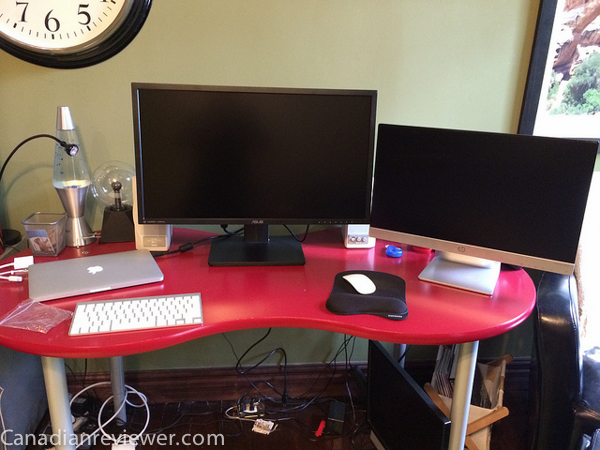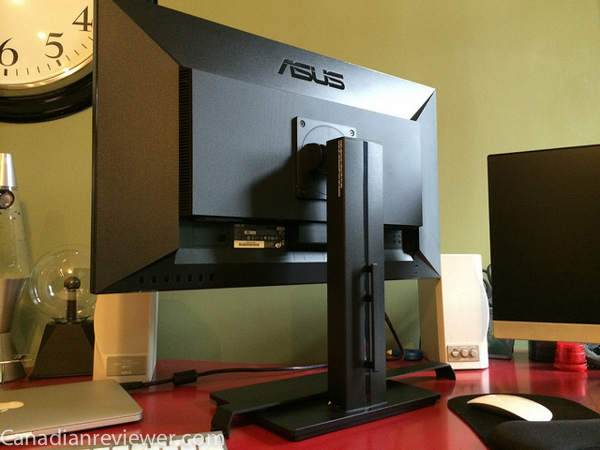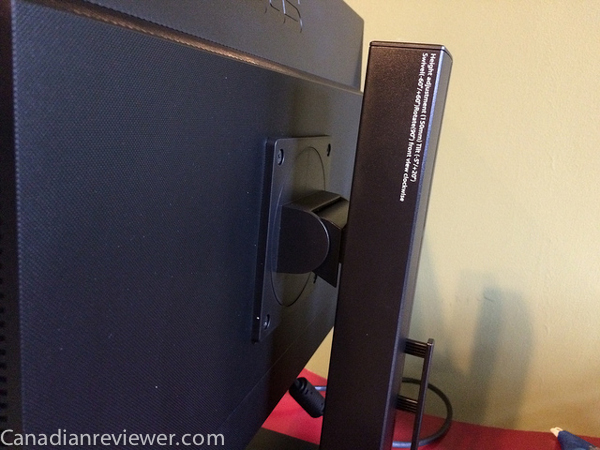 Going on sale this month for $699, the ASUS PB287Q welcomes us to the 4K-resolution revolution, where photos and videos look incredible… but you’re going to need your prescription updated for reading.
Going on sale this month for $699, the ASUS PB287Q welcomes us to the 4K-resolution revolution, where photos and videos look incredible… but you’re going to need your prescription updated for reading.
Text and photos by Simon Cohen
Over the years, we’ve seen a whole lot of innovation in computing. Faster processors, smaller form factors, touch-screen inputs and wireless data. All of these have had a profound impact on how and where we use technology. And as important as all of these advances have been, nothing has changed our fundamental relationship to these devices as much as improvements to their displays.
Displays are at the heart of how we perceive--and ultimately use—all of our computers, be it the biggest, most powerful desktop or the smallest of smartwatches. It’s the reason that new display technology always leaves me saying “wow.” That was my reaction when I saw my first high-res graphics monitor, when I saw my first colour LCD display and most recently, when I looked upon Apple’s Retina-equipped iPad. These technologies really enhance our use and enjoyment of computers.

So when I was offered the chance to try out ASUS’s PB287Q, one of the first reasonably priced 4K displays on the market, I jumped at the chance.
As an amateur photographer, I’m always on the lookout for better ways to show and work on my photos. I was blown away the first time I saw my photos on a 50” plasma TV—even at 720p—and was even more impressed by my computer of choice, a 27” iMac. But if you want to see your photos at a level of detail you could only achieve by using software magnification, you owe it to yourself to check out a 4K monitor.
Form Factor
The ASUS PB287Q has some impressive specs: 3840x2160 @60Hz native resolution, with a claimed gray-to-gray response time of 1ms. But even before you switch it on, the PB287Q will impress you with its well thought-out design.
Its satin-like all-black frame and stand are subdued, giving it an all-picture appearance. The controls are mounted to the back of the chassis, with subtle dot-indicators on the front of the bezel. This position isn’t intuitive at first, but once you get used to it, you’ll appreciate the way your thumb can rest on the front while your index finger presses the buttons.
The included stand provides 150mm of height adjustment and -5 to +20 degrees of tilt. The mechanism is very smooth and well balanced and height can easily be moved using one hand on the top or bottom of the display. It can also be rotated a full 90 degrees clockwise, but given its very wide dimensions, this can only be done when the monitor is at its maximum height. If you’d prefer to use your own mounting solution, the support arm can be removed and replaced with any 100x100mm compatible VESA fixture.
Around the back, cable management is handled by a combination of a guide that is easily snapped in and out of the support arm and an elegant port cover that is quickly and easily removed for access. You get two HDMI inputs (both of which are MHL-compatible), one DisplayPort, a 3.5mm audio-in jack and a similarly sized headphone output. The power adapter is internal to the chassis leaving only a standard three-prong power cable to deal with, not an awkward and bulky external box.
Overall, I think the PB287Q looks great on a desk, even when paired with Apple’s aluminum-finished products.
Picture Quality

It really comes down to this doesn’t it? I mean, why drop $700 on a monitor if it doesn’t look great? The good news is that the ASUS PB287Q does a beautiful job rendering high-resolution still imagery.
The screen’s 157 PPI pixel density means that all you notice are the details of your photos, not the details of your screen.
I ran it using the Thunderbolt ports on my iMac via a DisplayPort cable. With the contrast maxed out and brightness etc. set to my Mac’s calibration recommendations, the PB287Q delivers vibrant yet realistic colour, and only a tad cooler on the whites than my iMac’s native settings.
It’s still hard to get your hands on decent 4K video samples that aren’t streamed via YouTube N.B.: do not judge any 4K material that is streamed… it’s so highly compressed to allow for smooth real-time delivery, you lose a lot of detail.
But I found one at timescapes.org. The result? Gorgeous.
Text Quality
Here’s where you need to pay close attention if you are considering buying a 4K monitor as your primary display.
The reality is, with any high-resolution display, the more pixels you pack into a given space, the smaller those pixels need to be. When displaying high-res content, like 5-10 megapixel images, or 4K video, this is a good thing. Smaller pixels blend into one another, giving your high-res content a near-print level of quality.
The down side is that unless you’ve got a graphics card and software that can scale your other screen elements e.g. fonts, icons and other UI elements, these can become so small they can be tough to read or work with comfortably.
Apple’s Retina products do a phenomenal job with this scaling process, yielding UI elements that are the same size as they would be on non-retina displays, but with smoothness that is—dare I say it—perfect. Getting this level of scaling to happen on monitor like the PB287Q, using the native resolution settings offered by the Mac, proved difficult. Even at so-called “Hi-DPI” versions of 1080p, UI elements were certainly bigger, but lacked the crispness of a retina display set-up.
This means you need to accept one of two scenarios when using the PB287Q as a primary monitor:
A) You find the right combination of graphics card and software that will let you view UI elements at the right size, without sacrificing crispness, and hope that your ability to switch between resolutions is easy to do when you want to work at full 4K.
Or
B) You accept that running at the native 3840x2160 resolution means tiny UI elements, tons of desktop real estate, and text that is often grainy and jagged, because of the superb detail it offers when working high-res photos and video.
Of course, this may not bother you at all, especially if you’ve gone out of your way in the past—perhaps using CRT monitors--to max-out your screen real estate through super high resolutions. In this case, having a monitor that can do so natively might be just what you’re looking for. But I found that it was just too hard to work with such small screen elements.
Off-Angle Viewing
ASUS claims viewing angles of 170 and 160 degrees for horizontal and vertical respectively and I found that these were more than sufficient especially when paired with the PB287Q’s generous tilt adjustment. But when you rotate the screen into portrait mode, it gets trickier, especially if you want to sit side-by-side with a colleague to review material. Then you can run into some less than ideal problems with colour. It’s not a deal-breaker, just something to be aware of.
Compatibility
This, on the other hand, might be a deal-breaker. Not every computer can handle a 4K display. Even my late-2012 MacBook Pro Retina was unable to give me more than 1600x900 on the PB287Q, despite the fact that the machine should be able to deliver up to 2560x1900 on (two) external displays. And that’s a pretty recent machine running Apple’s latest version of OS X.
So before you think about snatching up the ASUS PB287Q or any other 4K monitor, make sure your computer of choice is up to the task.
ASUS is working on a list of compatible machines, but in the meantime they recommend that you’re going to use the PB287Q with a laptop, it must have an Intel Haswell core i3/corei5/core i7 CPU with HDMI 1.4 or DP 1.2 output.
Conclusion
4K monitors aren’t for everyone. Some people simply don’t need this extra level of resolution, while others will balk at the extra money you need to spend to get one. But if it’s value for money you’re worried about, consider this: Apple’s 27” Thunderbolt display has extra USB ports and can be daisy-chained with other Thunderbolt peripherals and has a built-in FaceTime camera, but it is smaller, has lower resolution, can’t be lifted or lowered, isn’t VESA compatible and can’t be rotated. It’s also $999.
For significantly less money, ($699) you can pick up the ASUS PB287Q, which arguably packs a whole lot more of what you buy a monitor for, namely, display capability.
That said, I would advise against using the PB287Q as your primary display. At 28” diagonal, with a native resolution of 3840x2160, the individual pixels are really, really small. It’s a huge plus when working with high-res imagery and video, but kind of a drag for other tasks.
But if you’re looking to add 4K to your desktop, and you don’t want to take out that second mortgage or stop paying for daycare, the ASUS PB287Q makes a fine and reasonably priced option.